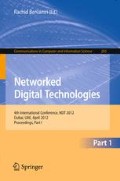Abstract
The present study conducted structural equation modeling (SEM) analyses on data collected from 1,011 participants in order to examine the role of Technology Acceptance Model (TAM) in predicting mobile map service users’ attitudes toward the service. Results from the analyses indicated that perceived mobility and perceived locational accuracy significantly influenced user acceptance and intention to use mobile map services via portable computing devices. In particular, increase in perceived mobility positively affected perceived usefulness while perceived locational accuracy also positively affected perceived usefulness and ease of use of using mobile map services. In addition, the present study revealed stronger effects of attitude on the behavioral intention to use than perceived usefulness, while the effects of perceived usefulness was stronger on attitude than perceived ease of use. Implications of notable findings and limitations are discussed.
Access this chapter
Tax calculation will be finalised at checkout
Purchases are for personal use only
Preview
Unable to display preview. Download preview PDF.
References
Oulasvirta, A., Estlander, S., Nurminen, A.: Embodied interaction with a 3D versus 2D mobile map. Personal and Ubiquitous Computing 13(4), 303–320 (2009)
Berg Insight AB, Mobile aps and navigation (2007), http://www.berginsight.com
Weiser, M.: The computer of the 21st century. Scientific American 265(3), 94–100 (1991)
Park, E., Kim, S., del Pobil, A.P.: Can I go there?: The Effects of Digital Signage on Psychology of Wayfinding Users. Journal of Next Generation Information Technology 2(4), 47–58 (2011)
Davis, F.D.: Perceived usefulness, perceived ease of use, and user acceptance of information technology. MIS Quarterly 13, 319–340 (1989)
Davis, F.D., Bagozzi, R.P., Warshaw, P.R.: User acceptance of computer technology a comparison of two theoretical models. Management Science 35, 928–1003 (1989)
Davis, F.D.: User acceptance of information technology: system characteristics, user perceptions and behavioral impacts. International Journal of Man-machine Studies 38, 475–487 (1993)
Venkatesh, V.: Determinants of perceived ease of use: Integrating control, intrinsic motivation, and emotion into the technology acceptance model. Information Systems Research 11, 342–365 (2000)
Venkatesh, V., Morris, M., Davis, G., Davis, F.D.: User acceptance of information technology: Toward a unified view. MIS Quarterly 27(3), 425–478 (2003)
Google Inc., Google Maps, http://maps.google.com
Google Inc., Google Earth, http://google.com/earth
Miller, C.C.: A beast in the field: The Google Maps mashup as GIS/2. Cartographica: The International Journal for Geographic Information and Geovisualization 41(3), 187–199 (2006)
Vandenburg, M.: Using Google Maps as an interface for the library catalogue. Library Hi Tech 26(1), 33–40 (2008)
Wikipedia, Google Maps, http://en.wikipedia.org/wiki/Google_Maps
Lisle, R.J.: Google Earth: a new geological resource. Geology Today 22(1), 29–32 (2006)
Patterson, T.C.: Google Earth as a (not just) geography education tool. Journal of Geography 106(4), 145–152 (2007)
The Official Blog of Google Inc., Google Earth downloaded more than one billion times, http://googleblog.blogspot.com/2011/10/google-earth-downloaded-more-than-one.html
Lee, J.K.: Web 2.0 and OpenAPI. In: The 14th Korea Internet Conference. Korea Internet Security Agency, Seoul (2006)
Lee, C., Yang, J., Kim, D., An, B., Kim, N.: Ubiquitous Service Model for Information Convergence of Jeju Island Culture, Tourism, Sport and Traffic. The Journal of The Institute of Webcasting, Internet and Telecommunication 8(4), 97–104 (2008)
NHN corporation, Naver Map, http://map.naver.com
Pagani, M.: Determinants of adoption of third generation mobile multimedia services. Journal of Interactive Marketing 18, 46–59 (2004)
Moon, J.W., Kim, Y.G.: Extending the TAM for a World-Wide-Web context. Information & Management 38, 217–230 (2001)
Huang, J.H., Lin, Y.R., Chuang, S.T.: Elucidating user behavior of mobile learning: A perspective of the extended technology acceptance model. The Electronic Library 25, 585–598 (2007)
Siau, K., Shen, Z.: Mobile communications and mobile services. International Journal of Mobile Communications 1, 3–14 (2003)
Loomis, J.M., Silva, J.A., Philbeck, J.W., Fukusima, S.S.: Visual perception of location and distance. Current Directions in Psychological Science 5(3), 72–77 (1996)
Anderson, J.C., Gerbing, D.W.: Structural equation modeling in practice: A review and recommended two-step approach. Psychological Bulletin 103, 411–423 (1998)
Fornell, C., Larcker, D.F.: Evaluating structural equation models with unobservable variables and measurement error. Journal of Marketing Research 8, 39–50 (1981)
Author information
Authors and Affiliations
Editor information
Editors and Affiliations
Rights and permissions
Copyright information
© 2012 Springer-Verlag Berlin Heidelberg
About this paper
Cite this paper
Park, E., Kim, K.J., Jin, D., del Pobil, A.P. (2012). Towards a Successful Mobile Map Service: An Empirical Examination of Technology Acceptance Model. In: Benlamri, R. (eds) Networked Digital Technologies. NDT 2012. Communications in Computer and Information Science, vol 293. Springer, Berlin, Heidelberg. https://doi.org/10.1007/978-3-642-30507-8_36
Download citation
DOI: https://doi.org/10.1007/978-3-642-30507-8_36
Publisher Name: Springer, Berlin, Heidelberg
Print ISBN: 978-3-642-30506-1
Online ISBN: 978-3-642-30507-8
eBook Packages: Computer ScienceComputer Science (R0)

